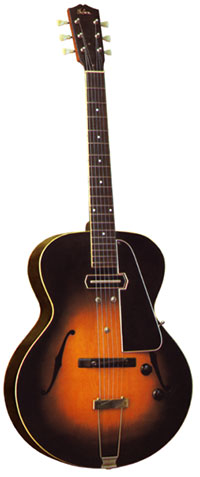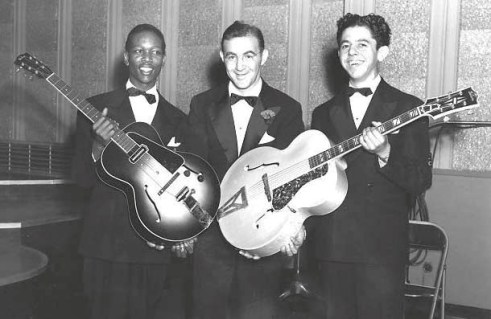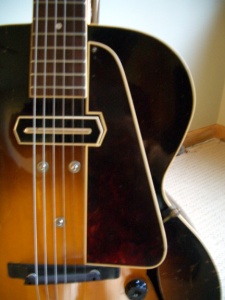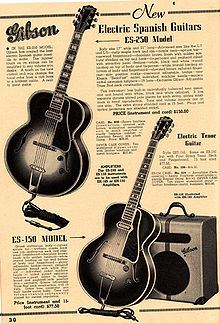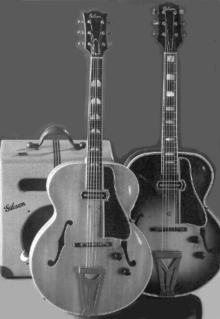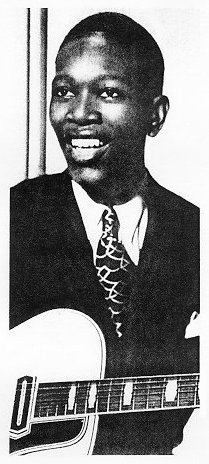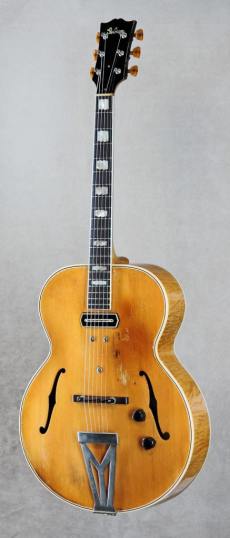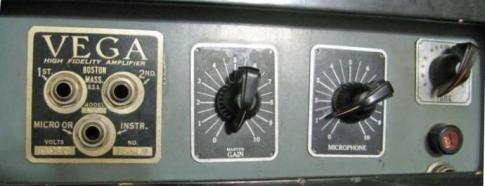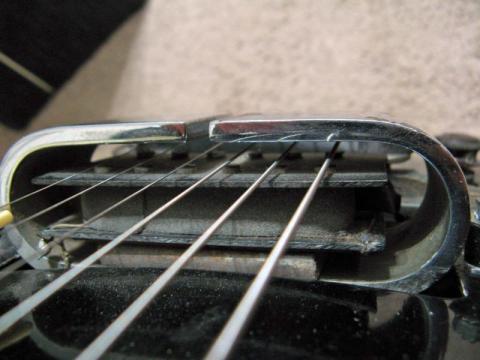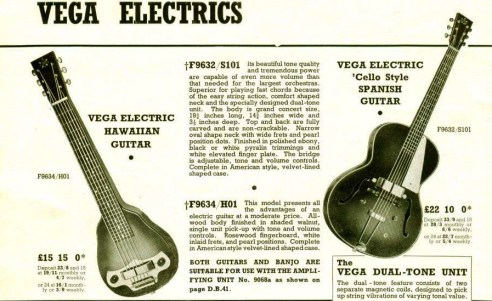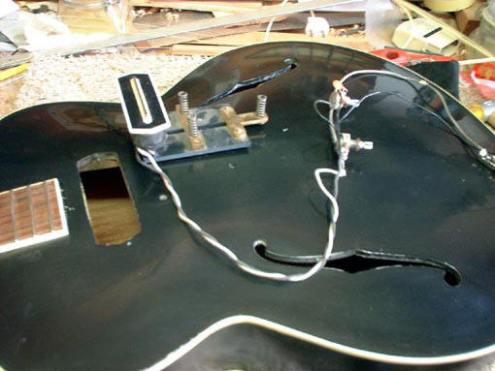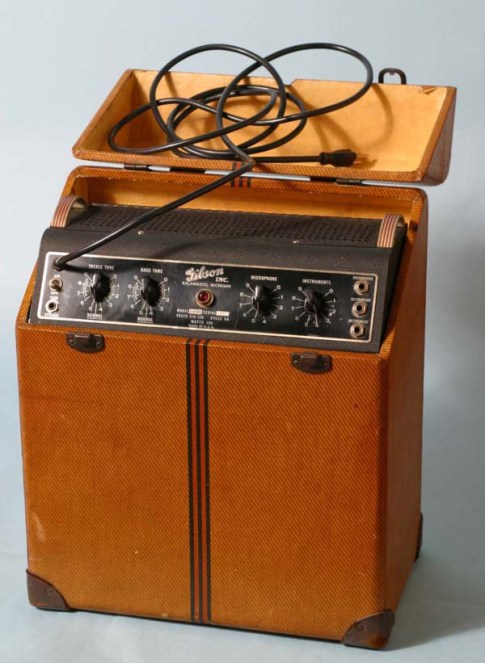Charlie Christian’s Guitars
The Gibson ES-150 was fitted with a single bar pickup, now generically known as a “Charlie Christian pickup,” which was adjustable for height and a slight tilt in relation to the strings via 3 screws mounted on the top of the body between the pickup and the bridge. The pickup itself was close to the fingerboard and this factor no doubt contributed to the deeper bass tone of the guitar. An output jack was located in the recessed base of the tailpiece. Christian adjusted the pickup closer to the body, away from the strings. This resulted in a warmer, more mellow “stringy” tone quality with less output.
Charlie poses with his Gibson Es-150 Guitar alongside Benny Goodman with his regular rhythm guitarist wielding a Gibson L-7 style acoustic guitar.
The ES-150 was essentially a 16-inch L-50 non-cutaway acoustic with a carved spruce arch top and maple back and sides. It had a mahogany neck with a very triangular “V shape,” a rosewood fingerboard with dot inlays, and an ebony bridge. It was not considered to be a “top of the line” instrument.
Charlie Christian used a Gibson ES-150 guitar plugged in to a Gibson EH-150 amplifier to create history. It is a very humble rig by the standards of today; but then today’s electric guitarists have Gibson and Christian to thank for proving what this instrument, and a great player, could do.
According to interviews in Peter Broadbent’s Charlie Christian: The Seminal Electric Guitarist, Minton’s manager, Teddy Hill, bought an EH-150 amp and a bar-pickup equipped ES-150 guitar (similar to the one from Christian’s early Goodman days) to keep at the club for his use (more on this later). Check out Charlie Christian – Live Sessions At Minton’s Playhouse on the Jazz Anthology label to hear why his playing and the sound of the ES-150 guitar through an EH-150 amp continue to thrill and inspire listeners and players the world over, as they have since 1939. While his playing surely could have transcended his equipment, the fact he used an EH-150 amplifier for a good portion of his career guarantees the model a place in the Vintage Guitar Amplifier Hall Of Fame.
Christian died of TB in 1942 aged 25.
Listen to any of the famous Django 1949 ‘Rome Sessions’ or the 1950 recording with Andre Ekyan – Reinhardt makes both Grappelli and saxophonist Andre Ekyan sound dated. By this time Django was going exclusively for an electric sound. Ironically it was during this period that he was fitting electric pickup’s to his Maccaferri, and was able to produce a cleaner more archtop type sound from his beloved Selmer. Indeed he once referred to the electric guitars in America as “casseroles”. But he wanted the electric/archtop voicing power and obviously went out of his way to find it.
Gibson ES-250
Gibson’s ES-250 was introduced in 1939 to offer electric guitarists a step up from the company’s 1st electric guitar, the ES-150. Among those who made the move to the larger, fancier model was jazz legend Charlie Christian. Christian’s association with the 2 Gibson models was so strong that the hexagonal pickup is commonly referred to today as the “Charlie Christian pickup,” and some jazz players still consider it to be the best jazz pickup ever made.
This was basically an L-7 type with a larger, superior-grade 17-inch body, “open book” inlays on the fingerboard, and a modified “Christian pickup” with a deeply notched blade to better balance the string response. Christian is thought to have played at least 4 of these models between 1939 and 1942
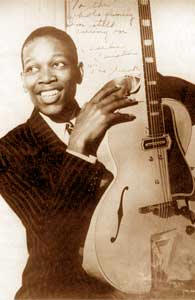
For Christian it may have been that he liked the fat, warm sound of the pickup in the neck position, as most all other companies had their pickups closer to the bridge, rendering a brighter tone and less sustain. Charlie liked that warm sustain for those horn lines. He was heavily courted by Gibson to continue using their guitars, but if he had not liked them he would have certainly switched. The fact that Gibson had built him a Special L-5 with a Charlie Christian pickup at a time when they were moving away from it to the new P-90 style would suggest that that was the tone he was searching for. The guitar was finished and delivered to New York just prior to Charlie’s death and ended up with the guitarist Tony Mottola.
Charlie Christian’s ES-250 – The logo is quite low and nearly sets on top of the D and G ferrules. It had been refurbished with a 2-piece carved back instead the pressed laminated one. The Factory Order No., which indicated it was from 1942, but this guitar was shipped to Charlie Christian on April 19, 1940 so it may have recorded the modification
Vega Co Boston, Electric Guitar
Christian played almost exclusively Gibson ES guitars. There is one shot of him with an early Vega (Star Logo) Guitar with the Rickenbacker-style pickup and Vega Amplifier, but he was clearly more of a a Gibson fan. Vega also produced high quality guitars. In the 1930s, the company built archtop guitars with backs and tops carved in the manner of violins. These became especially popular with jazz musicians. Eventually they produced electrified versions of these guitars.
Vega Hi Fi Amplifier Inputs and Controls
The Vega Co of Boston Electric Guitar is similar to other brands’ 1st steps into electrification in that it’s a mid-priced instrument. Nobody was sure in 1936 whether electric instruments were going to be a passing fad or not, so Gibson cautiously introduced the reasonably affordable ES-150 and Epiphone introduced the separate Electar brand for their electric instruments. Vega‘s contribution had a small (14 5/8″) body, a stencilled logo and minimal trim. The guitar was described as as having a carved top and back. Vega actually introduced a number of innovative features to help cut down on feedback: slightly later guitars were entirely laminated, and my guitar had factory sound posts. The big, heavy pickup also helped dampen vibration in the top. As you might expect from a horseshoe magnet, the pickup sounds a bit like a that found in a Rickenbacker lap steel. It has a similarly round, bell-like quality that’s both punchy and clear.
Note the UK Pricing – $4 exchange to a £1 back then.
The guitar had about as much output as a ’60s humbucker, which is a surprise from a pre-War instrument. Placing the pickup towards the bridge gave the guitar more mid clarity than its contemporaries.
The Vega Catalogue described the neck as “ovaled for comfortable easy fingering”, and the profile is surprisingly modern and easy to play. It excels at finger-picked blues, jazz, country. It is best to hear the guitar exactly the way Vega intended using the matching amp.
The Charlie Christian Pickup
– consists of a coil of copper wire wound around a black plastic bobbin.
The coil has a rectangular hole in its centre, and the coil and bobbin fit around a chrome-plated steel blade polepiece. Attached at right angles to the bottom of the polepiece are a pair of 5-inch-long (13 cm) steel bar magnets, which remain out of sight inside the instrument. These magnets are secured to the top of the ES-150 by the 3 set-screws visible on the guitar’s top. The entire assembly is about 6 inches (15 cm) long, and weighs nearly 2lbs (900 g). There were 3 different varieties of Charlie Christian pickup produced by Gibson, and all 3 are distinguished by the polepiece:
- The 1st of these was produced from 1936 until mid-1938 and had a plain blade polepiece. The coil was wound to about 2.4 kΩ resistance using AWG 38 enamelled wire.
- The 2nd type was introduced on ES-150s built from mid-1938 onward, and featured a polepiece that had a notch cut out below the 2nd (B) string. This modification was made to lower the volume of the B string, which sounded significantly louder than the other strings. At this time the coil was wound with a finer wire (AWG 42) resulting in more turns and an approximately 5.2 kΩ resistance, which gave the pickup a higher output.
- The 3rd pickup was available on the Gibson ES-250, which was available beginning in 1939. The blade on this pickup had 5 notches, each located between the strings. This pickup also had a more compact internal design. It featured a cobalt steel slug that was small enough to sit directly under the pickup.
The sound this pickup produced is clear – thanks to the narrow string-sensing blade – and powerful because of the relatively high resistance of the coil. Uneven magnetic flux within the steel magnets could cause some distortion in the signal. Electromagnetic hum was also a big problem with these pickups because of their large surface area and utter lack of shielding.
 Gibson EH-150 Amplifier was also used by Django and having looked at the interior wiring shots its a marvel that our man was not electrocuted mid solo flight.
Gibson EH-150 Amplifier was also used by Django and having looked at the interior wiring shots its a marvel that our man was not electrocuted mid solo flight.
The EH-150 amp cabinet was covered in “Aeroplane cloth“, luggage tweed, with contrasting vertical brown stripes. A black perforated aluminium grille protects the 10″ “Ultrasonic High Fidelity Reproducer” speaker. Later Gibson would often affix red stickers onto the back of speakers with the printed text “Ultrasonic Speaker“. Especially during the ’60s and ’70s. Chassis were mounted at the bottom of cabinets. The features of the early EH-150 amp include 1 input for microphone and 3 inputs for instruments, separate volume controls for the microphone and instruments sections, a bass-tone expander switch, and an “Echo” extension speaker jack.
For the microphone input stage of the early EH-150 one 6F5 tube (high mu triode) was used and 1/2 of an 6N7 (dual high mu triode) to provide gain for the instruments input and the 2nd half to a 2nd gain stage for both input stages, 1- 6C5 tube (medium mu triode) to serve as a 3rd gain stage and a transformer to split the phase of the amplified signal into 2 – 6N6 output tubes (direct-coupled power triodes. One 5Z3 rectifier tube was also used.
Amplifiers of the day were just as basic as the early electric guitars, if not more so. The EH-150 had in fact arrived before the ES-150 guitar, as partner to Gibson’s EH-150 lap-steel guitar (these were actually Gibson’s 1st genuine electric guitars, and the amplifier retained the lap steel’s “Electric Hawaiian” designation). The EH-150 originally carried a single 10″ speaker (later a single 12″) and was powered by a truly archaic circuit design, and now-obsolete preamp and power tubes, but it was an impressive beast for the mid ’30s. Even when the circuit had evolved a few years later to employ 6L6 output tubes, the amp still only produced around 15 watts at best, but that 15 watts sounded pretty darn loud next to any acoustic-only rhythm guitarist hacking away in the rhythm section, so these amps were enough to unleash the guitarist as soloist on the big-band stages of the day.
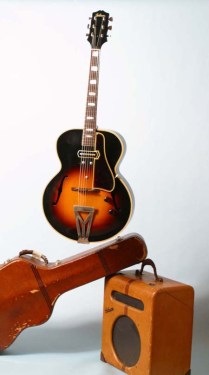 This hollowbody Archtop guitar with Period case and matching EH-185 20W Amplifier also made its debut in 1939. The following year the Gibson catalogue made the proclamation, “Gibson has created the best electric guitar possible to make.” It became a favourite of bluesman T-Bone Walker, who turned to it extensively during the ’40s and ’50s. Charlie Christian, Alvino Rey and Tony Mottola also fell for the instrument. Based on the ES-150 but with several bold upgrades, the ES-250 featured a larger body, refined fingerboard and snazzier accoutrements like deluxe headstock, tuners and tailpiece.
This hollowbody Archtop guitar with Period case and matching EH-185 20W Amplifier also made its debut in 1939. The following year the Gibson catalogue made the proclamation, “Gibson has created the best electric guitar possible to make.” It became a favourite of bluesman T-Bone Walker, who turned to it extensively during the ’40s and ’50s. Charlie Christian, Alvino Rey and Tony Mottola also fell for the instrument. Based on the ES-150 but with several bold upgrades, the ES-250 featured a larger body, refined fingerboard and snazzier accoutrements like deluxe headstock, tuners and tailpiece.
Perhaps its defining characteristic is its bar pickup with 6 mini blades that performed as separate polepieces for each string (now known as the “Charlie Christian Pickup”).
The ES-250 Guitar was a short-lived model. Charlie Christian owned 2 of the 70 that Gibson made. It featured the bar pickup that many jazz players still think is the best jazz pickup that Gibson ever made. It was superseded by the ES-300, which featured Gibson’s 1st adjustable-pole pickup, This was the Electric Guitar that Django used when touring with Duke Ellington in Nov 1946 but with a large Hybrid Amplifier.
Christian plugged his ES-150s and ES-250s into Gibson EH (Electric Hawaiian) amplifiers. Of these, he used 2 models: the EH-150 and the EH-185. The smaller EH-150 was offered as a matched set with the ES-150 guitar for a total price of $150. It had a 10-inch speaker, 6 tubes and an output of 15 watts. The EH-150 had two controls: volume and a two-position tone change switch for bass or treble sound. The larger EH-185 was an early “piggyback” style with the electronics of the amplifier mounted in a metal case under its “flip top” lid. The case could be separated from the cabinet to form a two-piece amp head and speaker box unit. The EH-185 had a 12-inch speaker, 7 tubes and an output of 18 watts. The controls again consisted of only volume and tone, but included a variable tone change control.
Gibson EH-185 18W Amplifier – Vintage Pre War Gibson Amp Demo
Christian used 2 of these amps 1 plain brown and 1 as illustrated.
